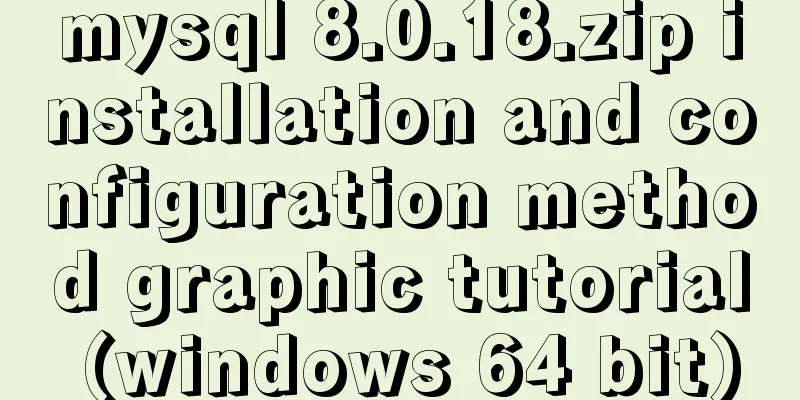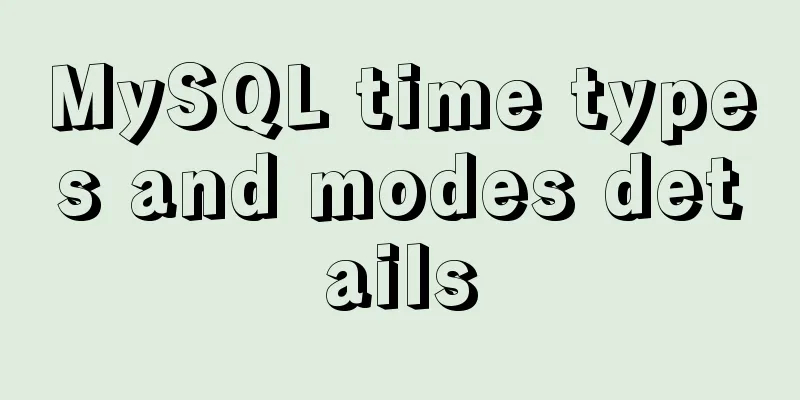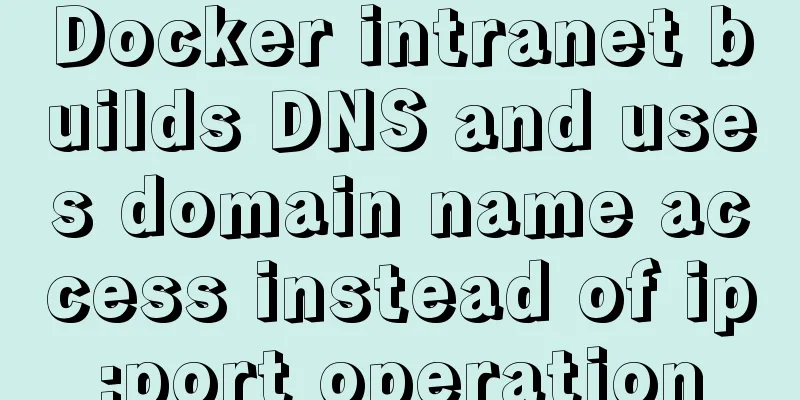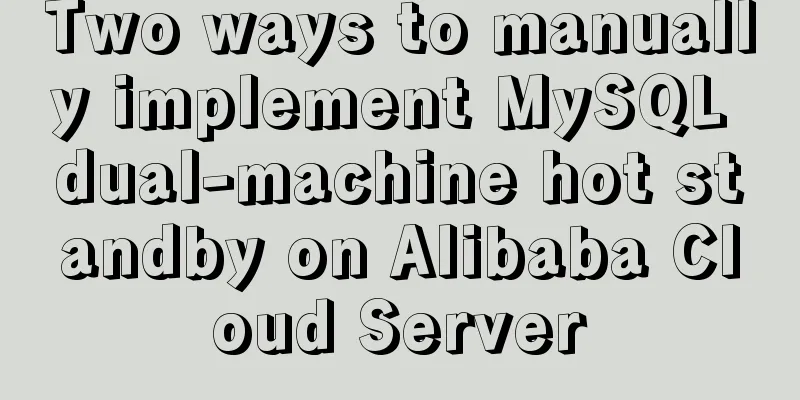Detailed explanation of Docker+Jenkins+Gitlab+Django application deployment practice
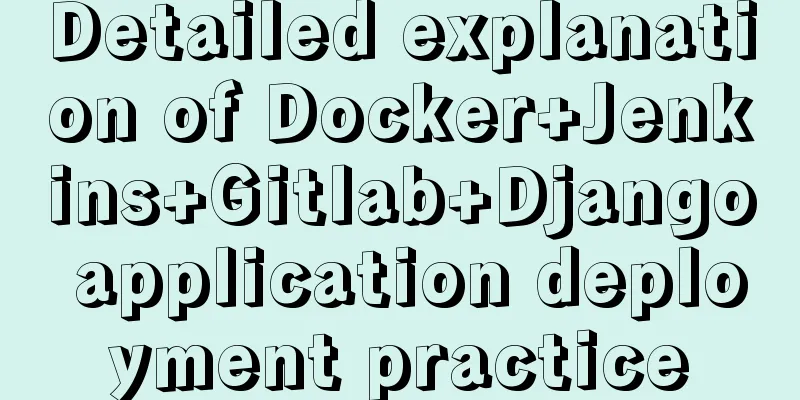
|
1. Background In the context of rapid updates and iterations of Internet applications, traditional manual work or simple scripts can no longer adapt to this change. Devops provides us with a good solution. The application of CI/CD can greatly facilitate our daily work. Automated and fast continuous integration/continuous delivery brings us faster application development, better stability and stronger reliability. 2. Topological Environment 2.1 Architecture Topology
As shown in the example above, the following process topology is briefly described:
2.2 System software version |
| name | Version |
|---|---|
| Linux | CentOS 7.3 64-bit |
| Docker | 1.13 |
| Django | 2.0 |
3. Installation and Deployment
3.1 Jenkins installation and deployment
For Jenkins installation and deployment, please refer to: Jenkins Notes
After the installation is complete, add the Docker target server

Configuring the outgoing mail server

3.2 Docker installation and deployment
For more information on Docker installation and deployment and Dockerfile writing, please refer to: Docker Container Detailed Explanation
3.3 Gitlab installation and deployment
GitLab can be installed on a public Linux server by running some commands. If there is no public network, you need to manually modify external_url 'http://自己的內網IP' in the /etc/gitlab/gitlab.rb file
yum install -y libsemanage-static libsemanage-devel policycoreutils openss
h-server openssh-clients postfix
systemctl enable postfix && systemctl start postfix
wget https://mirrors.tuna.tsinghua.edu.cn/gitlab-ce/yum/el7/gitlab-ce-8.0.
0-ce.0.el7.x86_64.rpm
rpm -i gitlab-ce-8.0.0-ce.0.el7.x86_64.rpm
# Get the public IP
PUBLICIP=$(curl http://ipv4.icanhazip.com)
# Modify sed -i "s/gitlab-server/${PUBLICIP}/g" /etc/gitlab/gitlab.rb
gitlab-ctl reconfigure
gitlab-ctl restart
echo "Username:root"
echo "Password:5iveL!fe"3.4 Configuration Release Process
Jenkins creates a free-style software project

Use parameterized builds to facilitate subsequent deployment of Docker imported mapping source ports and releases

The source code comes from the Django project of gitlab

Use webhook to connect gitlab and jenkins
Jenkins installation plugin:

Generate a random token value

Configure the GitLab webhook URL generated by jenkins to gitlab


When the developer pushes the code locally, Jenkins will automatically trigger the project build. There is a git pull code written in the Dockerfile. Again, there is no need to distribute the code from Jenkins to the Docker host. Jenkins is used as a trigger for Docker builds.

Configure the email after the build is completed
Email template, email type selection:
Content type selection: HTML
Fill in the email subject:構建通知:${BUILD_STATUS} - ${PROJECT_NAME} - Build # ${BUILD_NUMBER} !
Build the notification template:
<!DOCTYPE html>
<html>
<head>
<meta charset="UTF-8">
<title>${ENV, var="JOB_NAME"}-${BUILD_NUMBER} build log</title>
</head>
<body leftmargin="8" marginwidth="0" topmargin="8" marginheight="4"
offset="0">
<table width="95%" cellpadding="0" cellspacing="0"
style="font-size: 11pt; font-family: Tahoma, Arial, Helvetica, sans-serif">
<tr>
<td>(This email is automatically sent by the program, please do not reply!)</td>
</tr>
<tr>
<td><h2>
<font color="#0000FF">Build Result - ${BUILD_STATUS}</font>
</h2></td>
</tr>
<tr>
<td><br />
<b><font color="#0B610B">Build Information</font></b>
<hr size="2" width="100%" align="center" /></td>
</tr>
<tr>
<td>
<ul>
<li>Project name: ${PROJECT_NAME}</li>
<li>Build number: ${BUILD_NUMBER} build</li>
<li>SVN version: ${SVN_REVISION}</li>
<li>Trigger reason: ${CAUSE}</li>
<li>Build log: <a href="${BUILD_URL}console">${BUILD_URL}console</a></li>
<li>Build URL: <a href="${BUILD_URL}">${BUILD_URL}</a></li>
<li>Working directory: <a href="${PROJECT_URL}ws">${PROJECT_URL}ws</a></li>
<li>Project URL: <a href="${PROJECT_URL}">${PROJECT_URL}</a></li>
</ul>
</td>
</tr>
<tr>
<td><b><font color="#0B610B">Changes Since Last
Successful Build:
<hr size="2" width="100%" align="center" /></td>
</tr>
<tr>
<td>
<ul>
<li>Historical changes: <a href="${PROJECT_URL}changes">${PROJECT_URL}changes</a></li>
</ul> ${CHANGES_SINCE_LAST_SUCCESS,reverse=true, format="Changes for Build #%n:<br />%c<br />",showPaths=true,changesFormat="<pre>[%a]<br />%m</pre>",pathFormat=" %p"}
</td>
</tr>
<tr>
<td><b>Failed Test Results</b>
<hr size="2" width="100%" align="center" /></td>
</tr>
<tr>
<td><pre
$FAILED_TESTS
<br /></td>
</tr>
<tr>
<td><b><font color="#0B610B">Build log (last 100 lines):</font></b>
<hr size="2" width="100%" align="center" /></td>
</tr>
<!-- <tr>
<td>Test Logs (if test has ran):
href="${PROJECT_URL}ws/TestResult/archive_logs/Log-Build-${BUILD_NUMBER}.zip">${PROJECT_URL}/ws/TestResult/archive_logs/Log-Build-${BUILD_NUMBER}.zip</a>
<br />
<br />
</td>
</tr> -->
<tr>
<td><textarea cols="80" rows="30" readonly="readonly"
style="font-family: Courier New">${BUILD_LOG, maxLines=100}</textarea>
</td>
</tr>
</table>
</body>
</html>The trigger type can be filled in according to your needs. Here, fill in always to send an email regardless of success or failure.

View files in the remote Docker server

Django deployment has used conda to package the project's Python 3.6 environment package to create a Docker image.

Previously, a pure Python 3.6 system was used. During each build, pip was used to install the modules in requirements.txt. However, due to the seldom changes in the environment over time, pip installation was time-consuming each time. Therefore, conda was used to customize the packaged Python environment to reduce the environment deployment time. The local disk can also be mounted in the environment through the -v parameter of docker image creation. Each time, a local conda can be built to complete the rapid environment deployment.
View Dockerfile
FROM 87a69025db6a
MAINTAINER kaliarch
# Define the working directory ENV WORK_DIR /work/ in docker
# Create a working directory in docker RUN mkdir $WORK_DIR
# Define the mapping port EXPOSE 80
WORKDIR $WORK_DIR
RUN git clone http://123.xxxx.xxxxx.245/Devops/go2cloud.git
# Add startup service script ADD *.sh ${WORK_DIR}
CMD `which bash` /work/start_all.sh && tail -f /work/logs/server-$(date +%F).logView the Django startup script
#!/bin/bash
BASEPATH=$(cd `dirname $0`;pwd)
PY_CMD=/python3/bin/python
# Service entry file #MAIN_APP=${BASEPATH}/go2cloud/manage.py
# Migration script entry file SCRIPTS_APP=${BASEPATH}/go2cloud/scripts/migrate_task_schdule.py
# Delete the script entry file DELETE_APP=${BASEPATH}/go2cloud/scripts/delete_transfer_server.py
# Log directory LOG_DIR=${BASEPATH}/logs/
[ ! -d ${LOG_DIR} ] && mkdir ${LOG_DIR}
# Start the service #nohup ${PY_CMD} -u ${MAIN_APP} runserver 0.0.0.0:80 >> ${LOG_DIR}server-$(date +%F).log 2>&1 &
# Start the script migration scheduling script echo "---------$0 $(date) excute----------" >> ${LOG_DIR}task-script-$(date +%F).log
nohup ${PY_CMD} -u ${SCRIPTS_APP} >> ${LOG_DIR}script-$(date +%F).log 2>&1 &
# Start the migration and deletion script echo "---------$0 $(date) excute----------" >> ${LOG_DIR}delete-script-$(date +%F).log
nohup ${PY_CMD} -u ${DELETE_APP} >> ${LOG_DIR}delete-script-$(date +%F).log 2>&1 &View the Jenkins deployment script
#!/bin/bash
release=$1
port=$2
BASEPATH=$(cd `dirname $0`;pwd)
# Build go2cloud-platform image cd /dockerwork
docker build -t go2cloud-platform-mini:$release .
IMGNAME=$(docker images|awk -v release=$release '{if($1=="go2cloud-platform-mini" && $2==release) print $3}')
echo $IMGNAME
# Start the container docker run -d -p ${port}:80 -v /testlog/:/work/logs ${IMGNAME}Use the -v parameter to store logs persistently on the Docker host
4. Test display
4.1 Test Build
Manually build tests

4.2 View log



4.3 View Docker Container

4.4 Test the app

5. Reflection and Improvement
- The database currently connected is a database built on a cloud server. Later, the database also uses docker, and multiple groups use docker-compose for unified deployment and management.
- Later, you can use the public cloud k8s cluster for convenient testing
- Currently, the logs generated by the docker container are on the docker host. Later, they can be stored on cos and then delivered to the elk cluster for log visualization processing.
- Manage images in a unified way and create a local image repository
- Gitlab adds code review and combines it with automatic testing
The above is the full content of this article. I hope it will be helpful for everyone’s study. I also hope that everyone will support 123WORDPRESS.COM.
- Docker+gitlab+jenkins builds automated deployment from scratch
- Setting up GitLab+Jenkins continuous integration environment under centos (installing Jenkins)
- Docker Gitlab+Jenkins+Harbor builds a persistent platform operation
- jenkins+gitlab+nginx deployment of front-end application
- Jenkins integrates Gitlab to realize the whole process record of automated deployment
<<: MySQL deduplication methods
>>: How to generate Vue user interface by dragging and dropping
Recommend
Vue realizes dynamic progress bar effect
This article example shares the specific code of ...
Detailed discussion of the differences between loops in JavaScript
Table of contents Preface Enumerable properties I...
Detailed explanation of mandatory and implicit conversion of types in JavaScript
Table of contents 1. Implicit conversion Conversi...
How to display texture at the position of swipe in CocosCreator
Table of contents 1. Project requirements 2. Docu...
Detailed explanation of how to solve the problem of too long content in CSS
When we write CSS, we sometimes forget about the ...
Steps to build MHA architecture deployment in MySQL
Table of contents MAH 1. Introduction to MAH Arch...
Summary of common Mysql DDL operations
Library Management Create a library create databa...
Solve MySQL login error: 'Access denied for user 'root'@'localhost'
First of all, I don't know why I can't lo...
HTML+Sass implements HambergurMenu (hamburger menu)
A few days ago, I watched a video of a foreign gu...
Podman boots up the container automatically and compares it with Docker
Table of contents 1. Introduction to podman 2. Ad...
CSS3+HTML5+JS realizes the shrinking and expanding animation effect of a block
When I was working on a project recently, I found...
Build a WebRTC video chat in 5 minutes
In the previous article, I introduced the detaile...
Use Docker to build a Redis master-slave replication cluster
In a cluster with master-slave replication mode, ...
CentOS installation mysql5.7 detailed tutorial
This article shares the detailed steps of install...
Detailed tutorial on integrating Apache Tomcat with IDEA editor
1. Download the tomcat compressed package from th...

